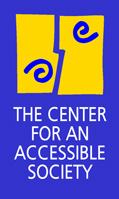
DISABILITY
ISSUES
INFORMATION
FOR
JOURNALISTS
ABOUT
THE CENTER
Talking signs technology liberates blind travelers
Note to readers: links to news articles may not work after a few weeks, as news media remove current stories to their archives. The link may take you to the archives section, where, for a fee, you can view the article.
May 8, 2001 -- "If a blind person cannot find a bus stop, locate and board the proper bus, navigate through a complex transfer station, or find boarding areas, fare machines, amenities, and doorways, they face functional barriers every bit as daunting as structural barriers" for people in wheelchairs, says James R. Marston, geographer with the University of California, Santa Barbara.
Research on "talking signage" -- called RIAS for "Remote Infrared Audible Signage" -- shows the great promise of this developing technology (read about Marston's research at http://ubats.org/csun.htm).
"I never knew the transit center had a change machine, or where the water fountain was," Jeane Adamson, one of the field testers, told researchers. Adamson fell in love with the "little voice," as she called it. "The thrill of hearing what bus I was getting on and where it was going was just indescribable!"
"With remote infrared audible signage we can independently become oriented to unfamiliar places, cross streets safely while staying in the crosswalk, create mental maps that translate to a broader orientation and enjoy a type of freedom that the sighted community just takes for granted," says accessible design consultant Jeff Moyer. "Orientation to public places is a civil right, as surely as getting into the building or using the telephone. Yet, when you look around you, where are the talking signs? Only in San Francisco." Read more from about talking signs as a right and a technology at http://ubats.org
Transit systems will likely be slow to adopt the technology, though, given findings from a new study from the Transportation Research Board. While transit systems nationwide seem to be "aware of legislation that requires them to improve access for persons with disabilities," the study says few report any "plans to expand their services or identified methods of providing service beyond that which the legislation required." ("Communicating with Persons with Disabilities in a Multimodal Transit Environment: A Synthesis of Transit Practice 37" is available online at http://nationalacademies.org/trb/publications/tcrp/tcrp37/).